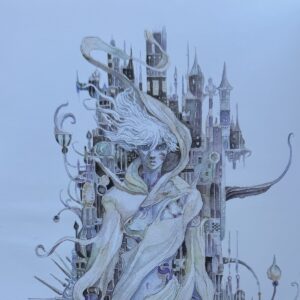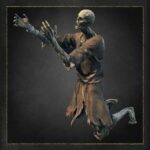I just recently finished my second reading of Elantris; I first read it last year during Summer of 2023. I came late to Sanderson, being repelled by the “hard fantasy” reputation, finally starting during Covid via audiobook. Now having read almost all of his Cosmere-related novels, I realize how misguided that prejudice was. There are some surprising (to me, at least) parallels between Dark Souls and Elantris. I see a few mentions of this in Sanderson fandom, but it was new to me coming more from the tabletop gaming side, so I figured others looking for megadungeon inspiration might be interested. I see only one rather irrelevant mention of Elantris in all of r/osr on Reddit, so maybe this really is not a common community overlap?
(Note: this post may include some spoilers, though I will avoid major plot details.)

I am not suggesting that Sanderson based his novel, published first in 2005, on Dark Souls, which was released in 2011, around six years later. Even Demon’s Souls, an ancestor of Dark Souls, was only released in 2009. Additionally, while it is possible Miyazaki Hidetaka was inspired by Elantris (he is an admitted appreciator of Western genre fantasy), I have no reason to believe in the reverse line of influence either. Nonetheless, the theme and style are strikingly similar, though Elantris develops the theme in an optimistic direction while Dark Souls develops the theme in a pessimistic (or at least wistful) direction.
In the novel Elantris, about 10 years ago relative to when the story begins, a mysterious event called the Reod initiated the transformation of the previously idyllic city of Elantris, populated by silver-skinned godlike beings, to slime-choked ruins, the Elantrians becoming zombielike undying creatures consumed by unending hunger and pain, with no ability to heal even the most minor of injuries. In the past as well as the present, Elantrians were not (are not) a separate kind of creature, but rather a kind of ascendency. Humans could become Elantrians. This continued to occur even after the Reod, though in the present becoming an Elantrian is treated more like contracting the plague, and the afflicted are banished to the now ruined Elantris, which is guarded to prevent any of the fallen Elantrians from escaping.

(City of the Gods: Yilancui)
(Elantris, Chinese title/cover)
Every surface—from the walls of the buildings to the numerous cracks in the paving stones—was coated with a patina of grime. The slick, oily substance had an equalizing effect on Elantris’s colors, blending them all into a single, depressing hue—a color that mixed the pessimism of black with the polluted greens and browns of sewage. … A dozen or so Elantrians lay scattered across the courtyard’s fetid stone. Many sat uncaringly, or unknowingly, in pools of dark water, the remains of the night’s rainstorm, And they were moaning. Most of them were quiet about it, mumbling to themselves or whimpering with some unseen pain. One woman at the far end of the courtyard, however, screamed in a sound of raw anguish. She fell silent after a moment, her breach or her strength giving out. Most of them wore what looked like rags—dark, loose-fitting garments that were as soiled as the streets. … This is what I will become, Raoden thought. It has already begun. In a few weeks I will be nothing more than a dejected body, a corpse whimpering in the corner.
Elantris, Chapter 1

Source: fextralife.com
Similar to the hollows of Lordran, some fallen Elantrians succumb to the unending (and ever-growing) pain, becoming Hoed, mindless undying creatures overwhelmed by suffering but functionally immortal unless burned, decapitated, or obliterated with overwhelming force (slight oversimplification, but sufficient for the purposes of this summary).
Let’s pause for a moment and appreciate the lovingly crafted megadungeon bones present in this setup. Almost immediately Sanderson presents the reader of Elantris with a series of memorable dungeon factions striving within the strange zombielike ecology of Elantris.
In addition to the stylistic similarities (huge ruined open air megadungeon city, remains of a lost golden age, suffering pseudo undead at risk of losing their humanity, lost golden age of possibly hubristic demigods), there is an additional, more interesting, and perhaps more fundamental symmetry between the persistence-rewarding gameplay of Dark Souls and the role of purpose in the (worldly) salvation of fallen Elantrians, at risk of losing their humanity to overwhelming suffering. In Dark Souls, you die, and learn, and die again. The journey of the human player mirrors the journey of the Chosen Undead protagonist, in avoiding going hollow, just as post-Reod Elantrians struggle to avoid the Hoed fate of despair.
The man had come looking for a magical solution to his woes, but he had found an answer much more simple. Pain lost its power when other things became more important. Kahar didn’t need a potion or an Aon to save him—he just needed something to do.
Elantris, Chapter 16











































